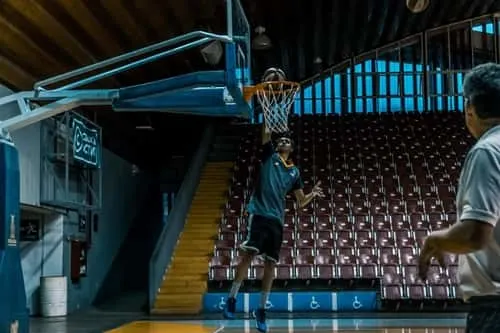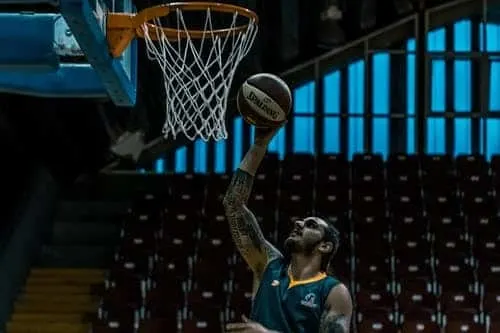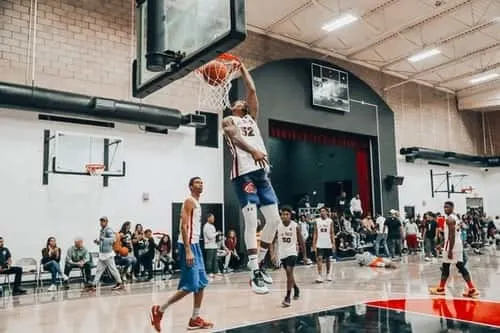There are 5 positions in basketball, all of which are interchangeable. From the point guard to the shooting guard, the shooting guard to the small forward and the small forward, and the power forward. And finally the power forward and Center position.
When it comes to the power forward and center position each has its differences, they are almost opposites of each other. The power forward plays at the high post position and takes outside shots while the center plays low post and shoots inside mostly. Although the power forward is better at playing the center position than the center is playing the power forward position. Being the biggest player on the court has its disadvantages on the court.
Let’s take a look at the role of each of these positions and see how they are similar and interchangeable and the major differences between the two roles. By the end of its article hopefully, you will come to an understanding of each position.
If you are thinking about buying a basketball jersey or shoes, check out the offers below from these retailers.
| Retailer | Promo Code | Promotion | Link to Retailer |
 | DROP | 70% OFF | Go to Fanatics |
 | PARSCR20 | 20% OFF | Go to Eastbay |
 | N/A | N/A | Go to Amazon |

Differences between a power forward and a center in basketball?
The power forward and the center are two different positions in basketball, and each would practice differently.
A center would work more with their back to the basket working on shots around the rim while the power forward may workout like a center but would add more outside shots depending on their range.
The center and pf will switch positions on the court, sometimes on purpose because the game forces them to.
The positions mirror the same role but can require a different skillset and attributes depending on the player.
The power forward’s role may play more like a guard depending on the coach’s offense, the game of basketball is changing and we are seeing a 4 guard offense and one center nowadays.
Players in general are becoming more skilled and are able to score better than ever.
The center position is playing a lot more like a power forward use to play when alongside the center, they are shooting more and much more skilled with the basketball.

The Power Forward position
The power forward position is known as the #4 position and is a good position for players that are tall but can move on very well on the court.
It is a mixture between the small forward and the center position. Think of the roles made up of a little of each position.
A power forward just like a small forward will shoot the ball from the three-point line and like the center will post up in the low post.
They will play on the opposite side of the center in the high post, looking to either get the ball from the wings and shoot the open shot or dive to the basket on a cut.
This position is ever-changing and we are seeing more outside shooting than ever before, especially at the three-point line.
Pick and rolls and mid-range shots are this position’s bread and butter. Diving to the basket for an easy layup works well depending on the player’s IQ.
This position is interchangeable on defense and switches happen with the center leaving the power forward having to play defense on the center.
Sometimes coaches will play a smaller lineup and have the power forward playing the center position.
This allows for a faster-paced game with a 5 out offense pulling the center that is on defense out from underneath the basket to open up the paint.
Power Forward Strength’s
- Can shoot and make the open shot.
- More mobile and quicker than the center.
- Fairly decent at free-throws.
- Can create mismatches.
- Good rebounder and shot blocker.
- Can switch on defense.
- Less prone to mismatches.

The Center position
The center is usually played by the tallest player on the team. On offense, the center plays around the key with their back against the basket in the low block position.
This position requires constant battle underneath the basket to get in scoring position. This position is very physical and this is why centers play fewer minutes than any other position.
They are in a battle of pushing and shoving to get the ball, it can literally feel like being in a fight.
The center is responsible for setting screens for the guards while they will roll to the basket, hoping to get a pass for an easy basket as they are generally open.
The center based on the offense a team will run may touch the basketball the least out of all the other positions.
But this position will draw more fouls than any other role, but centers are not well known for their shooting percentage at the free-throw line.
The center’s range is around 12 feet in. They pick up a lot of loose balls and rebounds for easy baskets.
On defense, the center position can be considered the defensive captain they have the best view on the court standing underneath the basket.
Their presence in the paint needs to be known to the other team as when players drive to the basket they will think twice when the center is there to contest the layup.
The center is also known as the rim protector and will make layup or shots around the basket more difficult.
Some centers are very physical when penetration happens and will let the players know about it. Hence make them think twice before coming down the lane again.
Strength’s of the Center
- Physically big and strong.
- A physically demanding and exhausting position.
- Good defensive rebounder and shot-blocker.
- Has good hands around the rim.
- Can play well with their back towards the basket.
- Set screens and can roll to the basket.

Should I play the Power forward or Center Position?
If you are a novice basketball player and are unsure of what position you should play there is actually an easy way to figure this out.
The simple way to be good at basketball right now is to figure what skill you are good at and choose the position you think will utilize that skill the best.
When it comes to the power forward position and center, players who are taller than the playing field play these positions, unless you are a freak of nature who can dribble and shoot like a guard you are most likely playing one of these roles.
If you are tall and strong but on the slower end, you are more likely to play the center position. If you are tall with some quickness and can shoot the outside shot, you may fit more into the PF role.
Understanding your strengths can help you decide what position you want to play, when you know what your strengths are an excellent way to get better quickly is to work on that skill that you’re already good at and double down on it.
For example, if you are good at shooting 12 to 15 feet from the outside, I would double down on this skill by practicing until you are an absolute threat every time you get the ball in that spot players will bite on your pump fakes and you can drive right by them for an easy basket.
Although sometimes we have it in our minds that we want to play a position but your coach says otherwise. You then may have no choice, if you want playing time you really need to adapt.
Height seems to make no difference in basketball anymore, as long as the players are skilled they will find their way on the court.
Players who are supposed to be power forwards and centers are no longer playing these positions like they are supposed to based on their height.
Kevin Durant is a classic example of a 6-foot 11-inch player, playing the shooting guard role.